Landblog Main
previous archive
Transforming Wood -- 11 May 09 -- "Slash" is the term for wood left on the ground after logging. Some of it is branches they cut off the trees they harvested, and some of it is whole trees they killed and didn't take because they were too small or bent.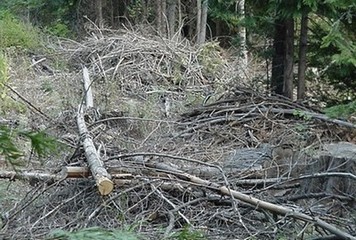 When I bought the land almost five years ago, it was covered with slash of all sizes, from twigs up to logs, scattered everywhere. My first project was clearing paths just so I could walk around. I threw some of the wood into piles, left most of it where it was, and figured in five years it would be mostly broken down. Ha! In the winter nothing breaks down because it's frozen, in the summer and fall nothing breaks down because it's bone dry, and even in the spring the slash breaks down slowly because most of it is not directly touching the ground and half of it is cedar.
When I bought the land almost five years ago, it was covered with slash of all sizes, from twigs up to logs, scattered everywhere. My first project was clearing paths just so I could walk around. I threw some of the wood into piles, left most of it where it was, and figured in five years it would be mostly broken down. Ha! In the winter nothing breaks down because it's frozen, in the summer and fall nothing breaks down because it's bone dry, and even in the spring the slash breaks down slowly because most of it is not directly touching the ground and half of it is cedar.At the same time, extreme weather and the delayed effects of logging have been killing more trees, so every year there is more dead wood, not less. The way nature takes care of this is for a fire to come through and burn it all. But the more dry wood is on the land, the hotter it will burn, and the more likely it will kill everything I planted and destroy everything I've built or stored.
The best thing to do with slash is to run it all through an industrial woodchipper and make a giant pile of chips which will turn to compost in just a few years. If I were part of a community, with lots of money and labor, I would totally push for the chipping option. Alone, I have to look at the easy options. The easiest would be to stay in the city playing video games until the whole range of hills burns up, and then go in and start planting and building. But that could take 25 years.
The next easiest option is to cover the slash piles with tarps and burn them after the first snowfall, or in the spring. That's what I've started doing, but even burning a single pile of wood tends to kill the nearby trees, not to mention the microbial life in the soil. So I've decided to limit the burning to three locations: the two spots I've already burned, and one more in the middle of the "parking lot" area. On this trip I made the entire third pile, but held off on the first and second piles until I finish gathering charcoal.
Charcoal is basically wood with everything burned out but the carbon. It's good for soil, and when mixed with compost and pottery shards, it forms the best soil humans have yet invented, terra preta. You can make charcoal by heating a bunch of wood to a high temperature in the absence of oxygen. Primitive people made it by digging pits, lighting bonfires in them, and then throwing dirt in. That's a bit hard to do alone, and by the time I get helpers, a bonfire will be too dangerous. But it turns out the big fire left quite a lot of charcoal, because the bottom of the pile was a mix of dirt and wood. On this trip I did some charcoal "mining", and I think I'll end up with enough to fill a 55 gallon drum.
Also, someone on the forums had the idea to accelerate the decay of the wood piles by covering them with leaves. Of course, I don't have any real leaves up there, because all the trees are conifers. But I do have some some dead ferns and dead grass, and I can haul up bags of leaves every fall from Spokane and throw them on the piles, and also throw water on throughout the summer. So, in addition to the three burn piles, I've started two wood composting piles, and if I get enough leaves this fall I'll do a third. At this rate, I should be able to clear away the worst of the slash in four or five years.
The Canals of Mars -- 23 May 09 -- In January the land is almost as cold as Mars, and in August it's almost as dry. But as you can see in the photos, there's plenty of water in May. On this trip my main activity was to move dirt so people can walk around in the springtime without getting their feet soaked.
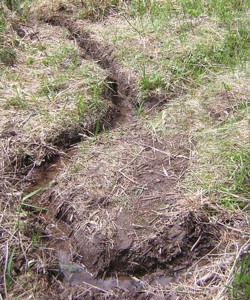 West of the "parking lot" area, over the big slash pile that I burned at the beginning of the month, is a swampy area that I haven't spent much time in because it's been overgrown and surrounded by piles of wood and pools of water. But last year I cleared the wood from one spot to make an entrance (just to the left of this photo), and the summer growth hasn't come up yet, so finally I could walk around and explore it. Curving around the uphill/west edge, like the upper tier of a shallow amphitheater, is a hump between two ruts, made by the logging vehicles seven years ago. The hump makes a perfect raised path, but both ends had puddles.
West of the "parking lot" area, over the big slash pile that I burned at the beginning of the month, is a swampy area that I haven't spent much time in because it's been overgrown and surrounded by piles of wood and pools of water. But last year I cleared the wood from one spot to make an entrance (just to the left of this photo), and the summer growth hasn't come up yet, so finally I could walk around and explore it. Curving around the uphill/west edge, like the upper tier of a shallow amphitheater, is a hump between two ruts, made by the logging vehicles seven years ago. The hump makes a perfect raised path, but both ends had puddles.At the entrance end, I carved this channel that accidentally looks like a question mark, to gather water at the bottom and side of the photo and drain it off at the top. And I piled the dirt on the path to raise it out of the water. I don't know if I'll leave the channels open or eventually fill them with gravel.
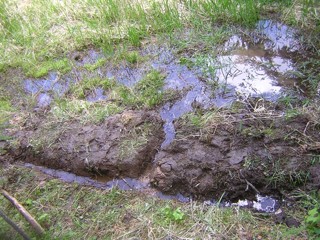 The far end of the path is much wetter because of an additional spring I discovered coming out of the base of the south hill, again at the bottom of the photo. The pool above is in shade most of the day, so I'd like to make it bigger and see how far into the summer I can keep it full. My neighbor says that before the most recent logging, the land had a little stream running year round.
The far end of the path is much wetter because of an additional spring I discovered coming out of the base of the south hill, again at the bottom of the photo. The pool above is in shade most of the day, so I'd like to make it bigger and see how far into the summer I can keep it full. My neighbor says that before the most recent logging, the land had a little stream running year round.After I did these, I dug another channel farther up to divert water across another path, instead of flowing down it, and send it a different way down to the swamp. I did the digging with a Fiskars all steel shovel, which is a bit heavier than a regular shovel, but a great pleasure to use, and I highly recommend it.
Plant Update -- 30 May 09 -- Yesterday I took a day trip up to the land to water stuff. Everything is leafed out now except the new peach, which is just starting to stick a few leaves out. The nectarine and all three apples that were broken by snow are sending up little sprouts from the base, so they might all recover. This year's apricot looks good, last year's is finally clearly dead, and the one from the year before, which did well for a while, seems to have given up after too much snow damage. So have the two American chestnuts, which were always unlikely. Four black walnuts are not dead yet, and one of them has been through two winters so it might really make it. The nice thing about the black walnuts is that they're seedlings and not clones of named varieties, which means they're cheap, and they're all genetically different, so if I keep planting them I'll eventually get some that tolerate dry summers.
Sea buckthorns are not cheap, and I've spent a lot on plants that died, but I've got two that have been there two years now, and two of the five new ones look great. The other two females are turning yellow at the tip, and the male has only put out a few leaves. They're supposed to be extremely drought tolerant, but apparently not when they're young.
All four cherries look good, except that the biggest still has a serious weak point where it got bent over by snow, so I tied a stick and some twine around it to reinforce it. One of the two Bali cherries is blooming for the first time, and also one of the two blue honeysuckles.
I'm taking a gamble on the three strongest and oldest apples. None of them were badly damaged by snow, they've been three years in spots relatively close to ground water, and they're on Antonovka rootstock which is strongly taprooted. So I'm not going to water them until July unless they show signs of drying out. [Update: this did not kill them but greatly reduced their growth.] I've found that the total amount of watering stays roughly the same year after year, as the plants from previous years either get established better or die.
I'm already making plans for next year. By the upper cherries, and also along the high edge of the swampy area, are prime east-facing growing areas, where plants can get a half day of light without being baked in the hot afternoons. I'd like to see if peaches and apricots do better in either of those places than where I've tried them before, and I can also try to do proper permaculture edges, with herbs and bushes in front of trees. I'd like to do more black currants and blueberries.
Also, I may eventually need trees to shield the land from the road. It appears to end on my land, but the plat map shows it curving through the bottom of the "parking lot" area and ending in the property to the east. So if that piece ever gets sold, or if loggers want to use the road, vehicles will be coming through. I want to grow a border of ginkgos and goumis, both tolerant of the hard-packed dry sand in that location. They're slow-growing, but it might be a while before I need them.
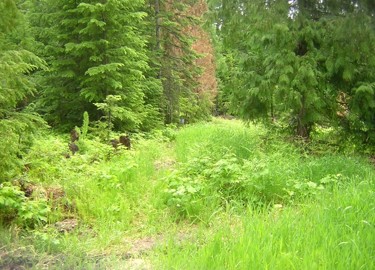 Jungle -- 9 June 09 -- In May most of the leaves haven't appeared yet, and in July they're already starting to dry down. June is the jungle month. And I spent this trip doing what people do in jungles: battling mosquitoes, and hacking out trails.
Jungle -- 9 June 09 -- In May most of the leaves haven't appeared yet, and in July they're already starting to dry down. June is the jungle month. And I spent this trip doing what people do in jungles: battling mosquitoes, and hacking out trails.If you've played the Legend of Zelda games, you're familiar with a certain kind of monster: they don't do much damage, but there are a lot of them, and they regenerate infinitely, so if you pass through their home area, you can't just stand around. You either have to run all the way through, or devote a lot of your attention to fighting them. Mosquitoes are exactly like that! They're good meditation teachers, because they force me to remain constantly aware of my senses, instead of getting too absorbed in what I'm doing.
I've improved my mosquito skills a lot since my big bike trip seven years ago. There I got more than 100 itchy bites in a few hours trying some tactics that didn't work, before I hit on the one that I still use: to be the hunter and not the hunted, by trying to kill and eat every mosquito that comes near me. Do not try this with ticks! They taste terrible and I heard about a guy who got Lyme disease from using his teeth to kill ticks he pulled off his dog. But mosquitoes taste surprisingly good. I've found it works best to crush them against my body just as they land, and the best way to kill them in the air is to reach out and close one hand over them, but you have to really keep your eyes on them. Also, a year or two ago I discovered that if I rub saliva into a fresh bite, it goes away instead of swelling and itching. Now the only time I get an itchy bite is when a mosquito manages to sneak a bite without me noticing.
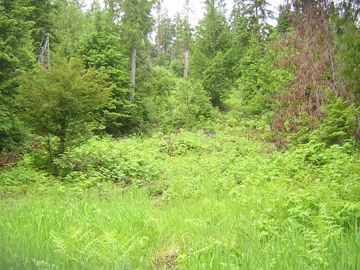 These photos were taken from the same spot near the bottom of the west hill. The one above is looking back toward the parking lot, and this one is looking west up the hill. Hidden behind the edge of the grass, and forming a crossroads with the uphill trail, is a trail I just made. It goes from the central clearing, past the golden russet apple tree, and straight into a tunnel I cut through the trees a couple years ago, going up to the wild south edge of the land. Trail-making requires a bit of digging, and a lot of pruning or trampling or killing thimbleberries or wild roses or small trees. I feel bad about it, but I often notice, when I come back to a trail after a year or two, that it's being used by deer, which feels like a stamp of approval.
These photos were taken from the same spot near the bottom of the west hill. The one above is looking back toward the parking lot, and this one is looking west up the hill. Hidden behind the edge of the grass, and forming a crossroads with the uphill trail, is a trail I just made. It goes from the central clearing, past the golden russet apple tree, and straight into a tunnel I cut through the trees a couple years ago, going up to the wild south edge of the land. Trail-making requires a bit of digging, and a lot of pruning or trampling or killing thimbleberries or wild roses or small trees. I feel bad about it, but I often notice, when I come back to a trail after a year or two, that it's being used by deer, which feels like a stamp of approval.Cabin Reboot -- 11 June 09 -- On the latest trip I did something I've been meaning to do for years: look at the full moon near the summer solstice. The full moon is always opposite the sun, so if the Earth's south pole is leaning toward one, the north pole is leaning toward the other. On any full moon night, the path of the moon across the sky is the same as the path of the sun at the opposite part of the year. So, by watching the full moon near the summer solstice, I can see where the sun will be near the winter solstice, and find out if it will warm the cabin.
It won't. It turns out the spot where I put the cabin footprint will be in shadow in winter mornings. I chose it because the trees to the east are a long way off, but in winter at this latitude the sun comes up in the southeast, not the east, and the trees to the southeast are tall enough to block the low sun. I could always cut the trees down, but it seems easier and nicer to just find a new spot for the winter cabin.
I walked around looking at spots higher up the north hill, and then later I was standing on the spot where I've been planning to build the practice hut. Even though it's at a lower elevation, and the trees to the east are closer, there's a good clear spot to the southeast where the canyon drops, and to the south where the road comes in. And if I back off a few paces north, to where the big slash pile was, it's slightly better.
I had already thought about using the slash pile spot to plant more fruit trees, but now I see that it's excellent for building. It's on a tiny plateau, several feet above the surrounding land (possibly because the loggers piled dirt there), so it's totally flood-proof. At the same time, it's low enough relative to the spring that I can lay a pipe and get good pressure. To the southwest it overlooks where a stream might eventually come through. I could put a duck shed behind it. And it's so close to the access road that you could almost drive to the doorstep.
That's also a disadvantage. If inspectors visit, they're sure to see it, so I'll have to look for loopholes in the building codes. And if the property to the east, at the actual end of the road, is ever sold to someone who drives a lot, then I'm screwed.
So, what do I do with the original cabin footprint? Right now I have a canvas tent there. Adam suggested putting it on a platform. That would prolong its life and make the inside more like a house, with a wooden floor that I could put rugs or furniture on. I figure I could lay down three or four cedar logs, charred on the side touching the ground, and then nail cheap lumber on top of them, and do the whole thing for around $200. I might try to fit the floor exactly inside the walls of the tent, with the bottom fringe of the tent hanging over them, and the tent poles fitting into the log foundation. That would use less wood and make everything last longer.
Then the question is whether to keep the tent up all winter, and risk getting it crushed under six feet of snow, or move the tent and all its contents into storage. I would probably do the latter, unless someone was going to be living there with a woodstove to melt the snow off.
Party of Two -- 23 June 09 -- A bunch of people expressed interest in coming to my work party, but only one person had enough free time to actually make it, an 18 year old from Sacramento named Derek. He was in Portland visiting his grandmother, and on Saturday he drove the extra 360 miles up to Spokane in his old diesel Mercedes, and then followed my truck up to the land.
It rained most of the time, but we did manage to move a couple piles of sticks, move a pile of heavy logs, improve the vehicle turn-around ramp, and begin to clear out the spot under the old slash pile where I recently decided to put the cabin. One nice thing about having visitors is they often notice things that I'm missing. Derek suspected that the three foot "plateau" was not just some scattered wood on top of hard-packed soil, but was soft soil and rotting wood all the way down. I dug some test holes and confirmed it. Without a backhoe it would take 100 hours to move it all, and there wouldn't be any point, because then the spot would no longer be raised, and anyway a plateau of soft soil and rotting wood is a perfect place to grow stuff. Permaculturists call it hugelkultur.
So now I'm thinking of putting the cabin a bit farther up the hill, where I now have a low-quality compost pile under the double cedar tree that got killed in the fire, and where everything I've planted has died, suggesting a subsoil that's dry and hard.
Also, Derek noticed that I have two different kinds of wild strawberries up there, and a bit of research revealed that one is regular wild strawberry, Fragaria virginiana, and the other is Fragaria vesca, known as woodland or alpine strawberry. You can tell the difference by feeling the top leaf surfaces with your lips -- virginiana is smooth and vesca is hairy. I should have checked that before I spent all that money on alpine strawberry seeds!
One other thing: while walking around, we accidentally scared a wild turkey off her nest. It was tempting to take one of the giant eggs and fry it up, but most likely there would have been a slimy turkey embryo inside, so we left them. The next day, checking out some native serviceberries, I came too close to the nest, and the turkey rushed at me, flapping her wings and sticking her neck out and hissing. It was scary, especially considering that birds are descended from dinosaurs. I forgot to bring the camera, but maybe next time I can get some pictures of the chicks.
Late June Roundup -- 29 June 09 -- The rainy season is over. It's going to be hot and dry now until October, and I'm going to have to arrange my work to stay in the shade during the warm parts of the day. But it's still getting cold at night. For example, at the nearest weather station, yesterday it was 80 (27C) and last night it was 39 (4C). I just poked around on weather.gov and can't find anywhere else in the country where it's still getting that cold. And Derek reminded me of something I'd forgotten: most plant growth happens during warm nights. That might explain why my apples grow only three inches a year.
Still, not a single apple or cherry has died. Counting natives, one invasive, and stuff I planted, there will be eleven edible fruits on the land this year: black huckleberries, wild strawberries, thimbleberries, oregon grapes, serviceberries, blackcap raspberries, tart cherries, aronias, black currants, blueberries, and blue honeysuckles. On this trip I started planning for the prime orchard area in what I call the central clearing, where I might have room for more black currants, blueberries, goumis, another peach and apricot, and grapes.
My other projects were to deepen a pool I dug in the swampy area, so I can get water without walking up to the spring, walk around taking more pictures, drain almost four gallons of dirty gasoline out of a 55 gallon drum I got on freecycle, and make yet another change in building plans. But I have a new policy. Research shows that telling people you're going to do something makes it more difficult to do it. It's already damn near impossible for me to do any building. So from now on, all posts about building will be looking backward at stuff I've already done.